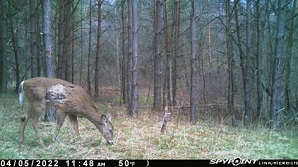Hunting and Trapping Newsletter
The New York State Department of Environmental Conservation sent this bulletin on 04/25/2023 02:45 PM EDT |
| DEC Delivers - Information to keep you connected and informed from the NYS Department of Environmental Conservation |
| View in browser |
Hunting and Trapping Newsletter |
Deer Shed Their Winter Coats
Over the coming weeks, white-tailed deer will be shedding their brown/grey winter coats or hair, which will be replaced by a summer coat with more reddish coloration. This process, and the resulting patchiness in a deer’s coat, can be mistaken by observers as a sign of illness or injury, but is a natural process that helps deer thermoregulate throughout the seasons. The reverse process (deer shedding their summer coat for their winter one) typically occurs in early to mid-September. A white-tailed deer’s winter coat is comprised of dense, hollow hairs that provide insulation against cold winter temperatures and snow. This coat is so well adapted to hold in a deer’s body heat that snow often accumulates on deer while they are bedded during winter storms. The summer coat, on the other hand, is comprised of thin, lighter hairs that are meant to help deer stay cool during the warm summer months. The change in dark to lighter hair coloration also likely helps deer absorb heat from the sun during the winter and reflect it in summer. Deer observed with patches of bare or leathery skin or with patchy coats during other times of year could be experiencing disease or various forms of skin irritation. Skin mites and other parasites can irritate a deer’s skin and in severe instances a deer may pull or rub out clumps of its own hair in an attempt to remove the mites. Although less common, it is also possible for deer to contract mange. DEC encourages the public to report incidents of deer with severe hair loss, preferably including a photograph of the animal. Spring Turkey Season Opens May 1 and Now Includes Suffolk County Hunting OpportunitiesSpring turkey season opens May 1, in all counties north of the Bronx-Westchester County boundary and, new for 2023, in Suffolk County on Long Island (Wildlife Management Unit 1C). In addition to the new opportunities on Long Island, another change that went into effect last fall allows shot sizes as small as Number 9 for turkey hunting. This regulatory change affects both the spring and fall seasons statewide. The change was made to modernize regulations as technology has advanced over the years to increase the down-range effectiveness of smaller shot sizes. Spring turkey harvest in New York averages about 18,000 birds and varies based on the number of participants and turkey productivity in previous springs. This spring, improved turkey harvest is expected compared to last year. Hunters prefer to take toms (2+ year-old birds) typically producing a two-year lag between summer productivity and spring take. Overall, turkey populations are lower now than a few years ago due to below-average reproductive success two of the last four years. However, improved turkey productivity in 2020 and 2022 means a greater proportion of toms available to hunters this spring compared to last year. Other Important Details for the Spring Turkey Season, May 1-31:
Tips for a Successful and Safe Turkey Hunting Season
Hunt Safe, Hunt Smart!While statistics show that hunting in New York State is safer than ever, mistakes are made each year. Every hunting-related shooting incident is preventable. DEC encourages hunters to use common sense this season and remember what they were taught in their DEC Hunter Education Course including:
A hunter education class is required for all hunters. To find a hunter education class in your area, visit DEC's Hunter Education Program website or call 1-888-HUNT-ED2 (1-888-486-8332). Buy Sporting Licenses OnlineSporting licenses may be purchased online at any time and anglers may use their privileges immediately by simply carrying their transaction number (DEC-LS#) with them while afield. Anglers, hunters, and trappers may also use the HuntFishNY mobile app to display an electronic copy of their license. The HuntFishNY app is available for download through the Apple App or Google Play stores. Back tags and carcass tags must still be mailed, and customers should allow 10-14 days for receipt of their tags. Please visit our website for more information about sporting licenses. Citizen Science Opportunity: DEC Seeks Turkey Hunters for Ruffed Grouse Drumming SurveyTurkey hunters can record the number of ruffed grouse they hear drumming while afield to help DEC track the distribution and abundance of this game bird. To get a survey form, go to DEC's website or call (518) 402-8883. To participate in DEC's Summer Wild Turkey Sighting Survey or other wildlife surveys, visit the "Citizen Science" page of DEC's website. |

